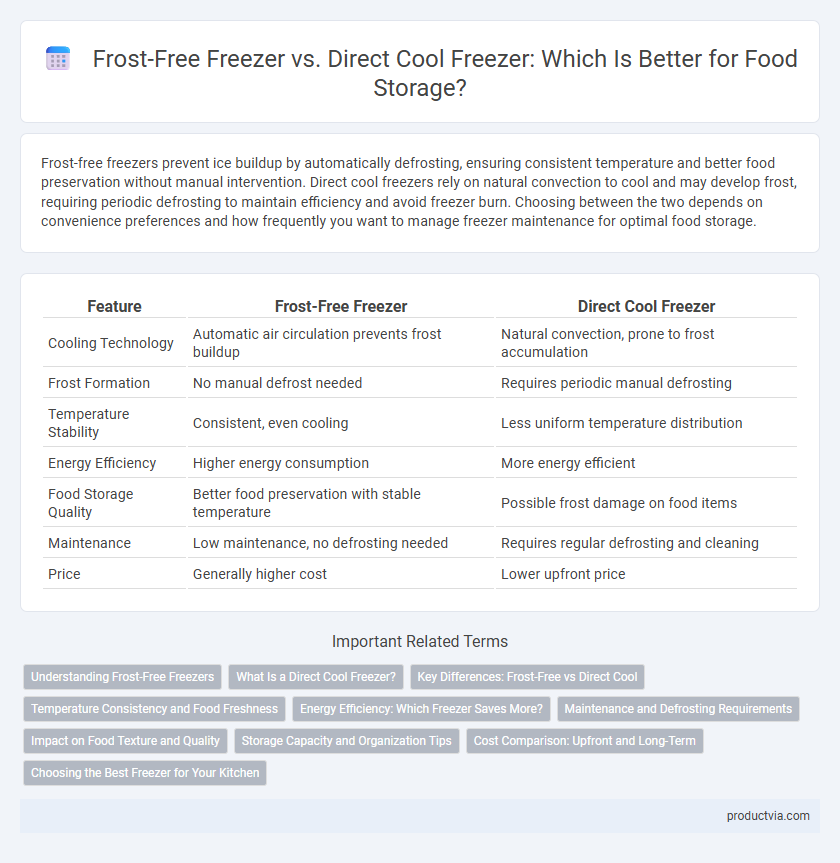Frost-free freezers prevent ice buildup by automatically defrosting, ensuring consistent temperature and better food preservation without manual intervention. Direct cool freezers rely on natural convection to cool and may develop frost, requiring periodic defrosting to maintain efficiency and avoid freezer burn. Choosing between the two depends on convenience preferences and how frequently you want to manage freezer maintenance for optimal food storage.
Table of Comparison
| Feature | Frost-Free Freezer | Direct Cool Freezer |
|---|---|---|
| Cooling Technology | Automatic air circulation prevents frost buildup | Natural convection, prone to frost accumulation |
| Frost Formation | No manual defrost needed | Requires periodic manual defrosting |
| Temperature Stability | Consistent, even cooling | Less uniform temperature distribution |
| Energy Efficiency | Higher energy consumption | More energy efficient |
| Food Storage Quality | Better food preservation with stable temperature | Possible frost damage on food items |
| Maintenance | Low maintenance, no defrosting needed | Requires regular defrosting and cleaning |
| Price | Generally higher cost | Lower upfront price |
Understanding Frost-Free Freezers
Frost-free freezers use an automatic defrosting system that prevents ice buildup by circulating cold air evenly, ensuring consistent temperature and food quality over time. This technology reduces the need for manual defrosting, maintaining optimal storage conditions for a variety of frozen foods without frost accumulation. In contrast to direct cool freezers, frost-free models offer greater convenience and better long-term preservation of food texture and flavor.
What Is a Direct Cool Freezer?
A direct cool freezer uses natural convection to circulate cold air, resulting in cooler temperatures but often causing frost buildup on the walls. This type of freezer is energy-efficient and typically less expensive, making it suitable for short-term food storage or smaller quantities. However, it requires manual defrosting to prevent ice accumulation, which can affect overall performance.
Key Differences: Frost-Free vs Direct Cool
Frost-free freezers use an automatic defrosting system that prevents ice build-up, maintaining consistent temperature and better food preservation. Direct cool freezers rely on natural convection for cooling, which can lead to frost accumulation requiring manual defrosting and potentially uneven temperatures. Choosing between frost-free and direct cool depends on energy efficiency preferences, maintenance willingness, and the desired convenience in food storage.
Temperature Consistency and Food Freshness
Frost-free freezers maintain consistent temperatures by automatically defrosting ice buildup, preventing frost accumulation that can affect food texture and freshness, making them ideal for long-term storage. Direct cool freezers rely on natural convection, which can lead to uneven temperatures and ice formation, potentially compromising food quality and requiring manual defrosting. Consistent temperature control in frost-free freezers better preserves nutrients and extends the shelf life of stored items compared to direct cool models.
Energy Efficiency: Which Freezer Saves More?
Frost-free freezers use an automatic defrosting system that prevents ice build-up but typically consume more energy than direct cool freezers due to the continuous operation of a fan and defrost heater. Direct cool freezers rely on natural convection for cooling without requiring a fan, resulting in lower electricity consumption and better energy efficiency. Homeowners prioritizing energy savings should consider direct cool freezers, especially in environments where manual defrosting is manageable.
Maintenance and Defrosting Requirements
Frost-free freezers feature an automatic defrost cycle that reduces the need for manual defrosting and minimizes ice buildup, making maintenance easier and more convenient. Direct cool freezers require regular manual defrosting to prevent frost accumulation, which can affect cooling efficiency and food quality over time. Choosing between these depends on the desired maintenance frequency and convenience, with frost-free models offering lower upkeep at a higher energy cost.
Impact on Food Texture and Quality
Frost-free freezers use automatic defrosting that prevents ice buildup, preserving food texture and quality by reducing freezer burn and moisture loss. Direct cool freezers rely on natural convection to cool, often leading to uneven temperatures and ice formation that can damage food texture and degrade freshness. For long-term food storage, frost-free models maintain better overall food quality by minimizing freezer frost and moisture fluctuations.
Storage Capacity and Organization Tips
Frost-free freezers offer larger storage capacities and maintain even temperatures, preventing ice buildup and allowing better organization with adjustable shelves and compartments. Direct cool freezers usually have smaller capacities and require manual defrosting, making it essential to use stackable containers and label items for efficient space utilization. Properly organizing both types enhances food preservation by minimizing temperature fluctuations and maximizing airflow.
Cost Comparison: Upfront and Long-Term
Frost-free freezers typically have higher upfront costs than direct cool freezers due to advanced automatic defrost technology. However, they offer long-term savings by preventing ice buildup, which can improve energy efficiency and reduce maintenance expenses. Direct cool freezers are more budget-friendly initially but may incur additional costs over time from manual defrosting and potential ice-related issues affecting food storage quality.
Choosing the Best Freezer for Your Kitchen
Frost-free freezers prevent ice buildup through automatic defrosting, ensuring consistent temperature and minimal maintenance, ideal for long-term food storage. Direct cool freezers use natural convection for cooling and require manual defrosting, offering energy efficiency but less convenience. Choosing the best freezer depends on kitchen space, usage frequency, and preference for low maintenance versus energy savings.
Frost-free freezer vs Direct cool freezer for food storage Infographic

 productvia.com
productvia.com